Abstract
Partial unresponsiveness to 2,4-dinitrofluorobenzene (DNFB) was produced by the epicutaneous application of 2 per cent 2,4-dinitrothiocyanatebenzene (DNTB) to the dorsum of the ear, 14 and 7 days before sensitization. This state of partial unresponsiveness could be broken by treatment with 300 mg/kg cyclophosphamide (CY) 3 days before the sensitization dose of DNFB. There was a significant increase in the uptake of 125I-labelled iododeoxyuridine in the draining lymph node, 6 days after the application of 2 per cent DNTB and in the contralateral nodes at 4 and 6 days. The state of partial unresponsiveness to DNFB was not associated with a decrease in T-cell proliferation in the draining lymph nodes. The generation of suppressor cells, capable of reacting in the periphery, was demonstrated by passive cell transfer into recipients sensitized to DNFB and depleted of normally produced suppressor cells by pretreatment with CY. These cells were found in spleen and peritoneal exudates of animals treated by the epicutaneous application of 2 per cent DNTB 14 and 7 days previously. It is suggested that the suppressor cells induced by contact with DNTB act by competition with effector cells at the periphery.
Full text
PDF
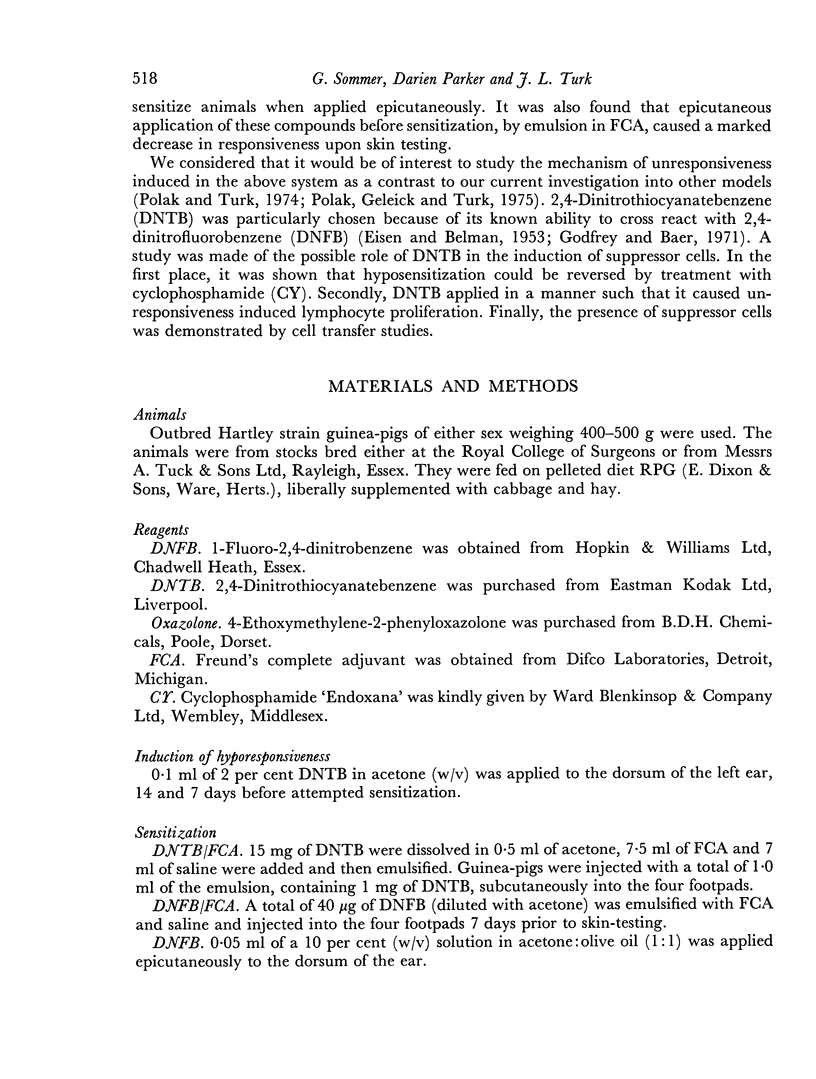


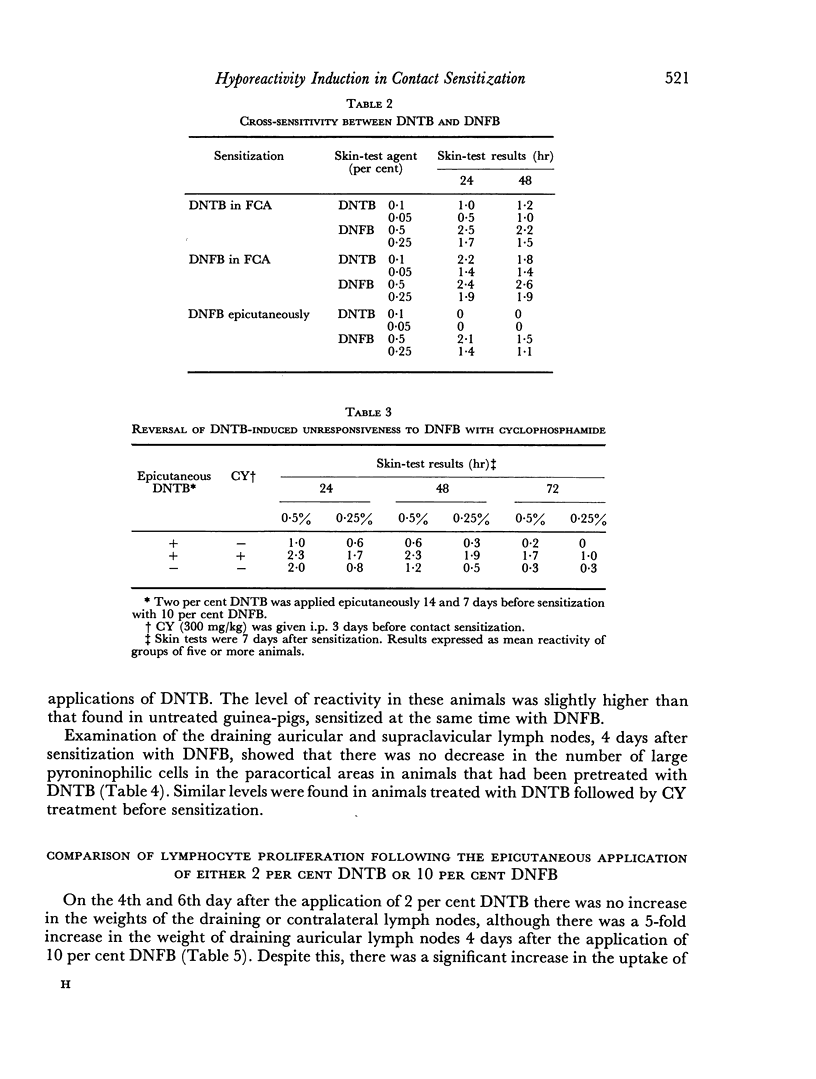

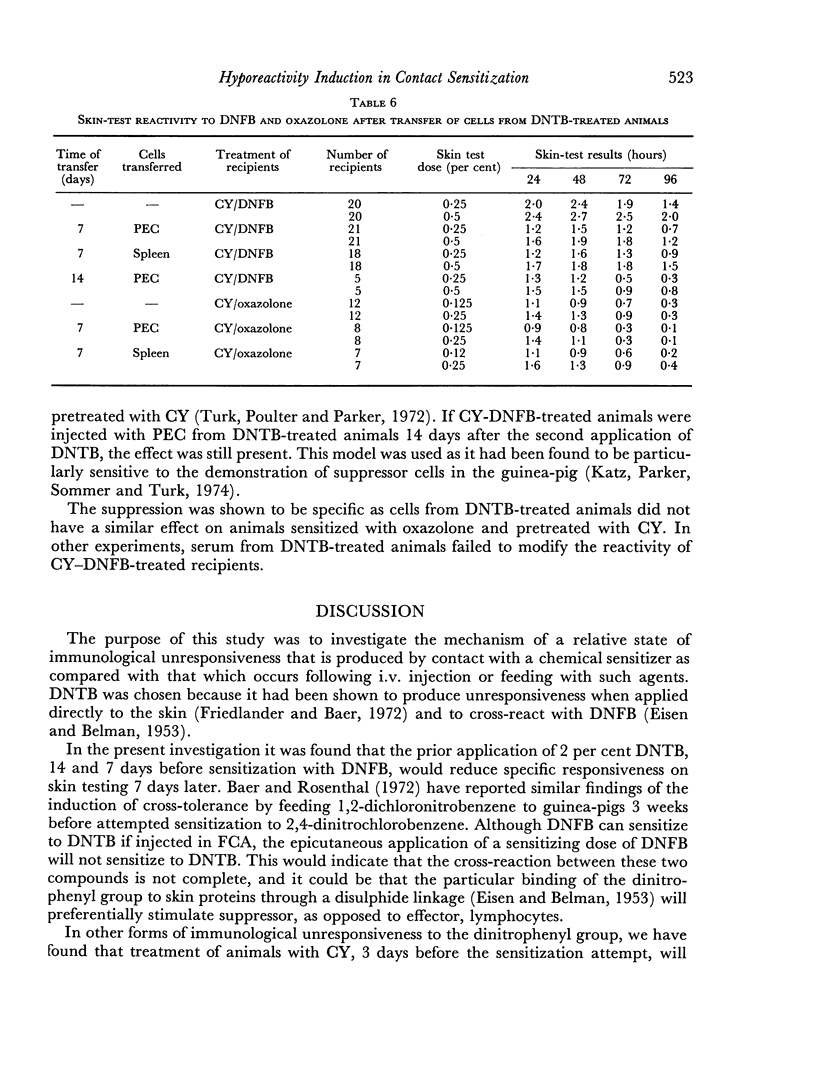
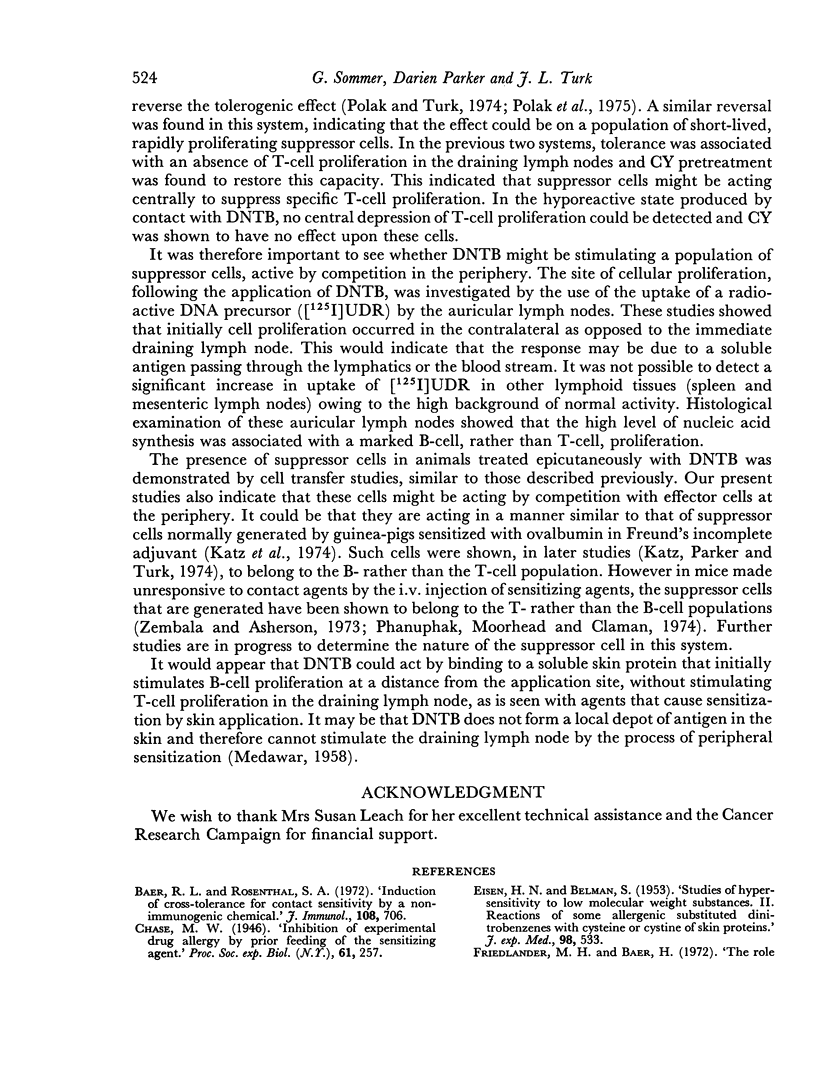
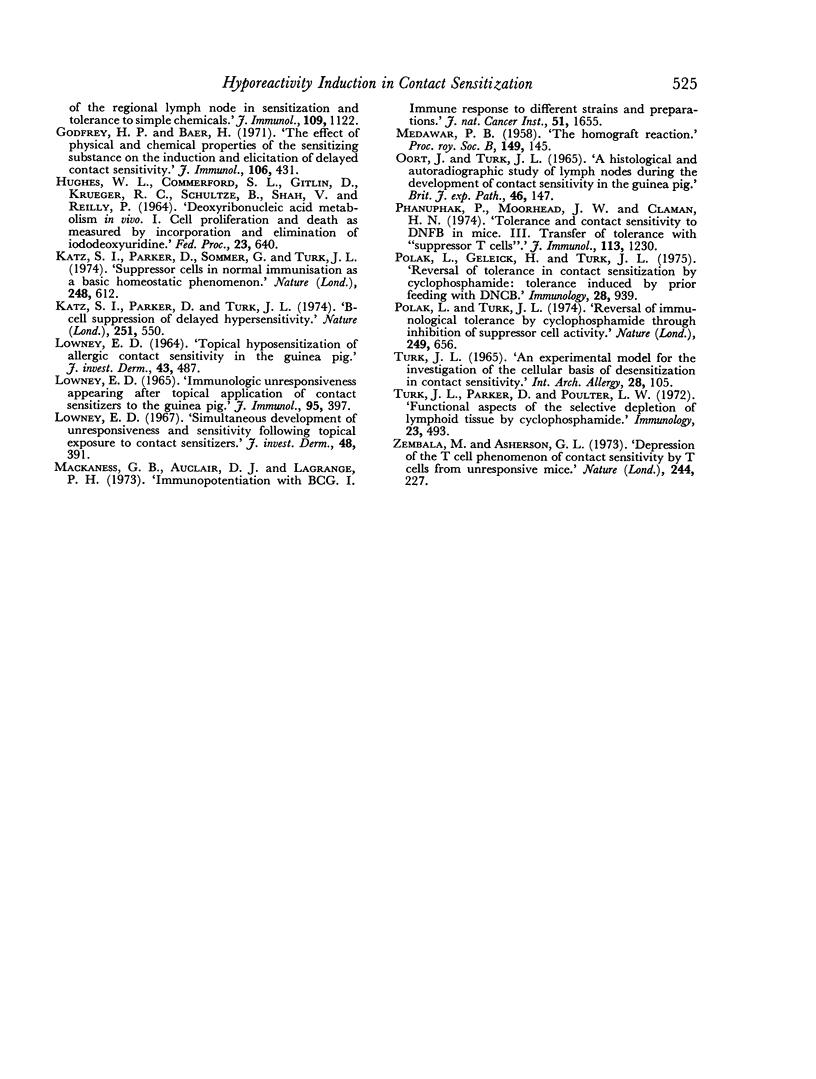
Selected References
These references are in PubMed. This may not be the complete list of references from this article.
- Baer R. L., Rosenthal S. A. Induction of cross-tolerance for contact sensitivity by a non-immunogenic chemical. Feeding dichloronitrobenzene induces tolerance to dinitrochlorobenzene. J Immunol. 1972 Mar;108(3):706–710. [PubMed] [Google Scholar]
- EISEN H. N., BELMAM S. Studies of hypersensitivity to low molecular weight substances. II. Reactions of some allergenic substituted dinitrobenzenes with cysteine or cystine of skin proteins. J Exp Med. 1953 Dec;98(6):533–549. doi: 10.1084/jem.98.6.533. [DOI] [PMC free article] [PubMed] [Google Scholar]
- Friedlaender M. H., Baer H. The role of the regional lymph node in sensitization and tolerance to simple chemicals. J Immunol. 1972 Nov;109(5):1122–1130. [PubMed] [Google Scholar]
- Godfrey H. P., Baer H. The effect of physical and chemical properties of the sensitizing substance on the induction and elicitation of delayed contact sensitivity. J Immunol. 1971 Feb;106(2):431–441. [PubMed] [Google Scholar]
- HUGHES W. L., COMMERFORD S. L., GITLIN D., KRUEGER R. C., SCHULTZE B., SHAH V., REILLY P. DEOXYRIBONUCLEIC ACID METABOLISM IN VIVO: I. CELL PROLIFERATION AND DEATH AS MEASURED BY INCORPORATION AND ELIMINATION OF IODODEOXYURIDINE. Fed Proc. 1964 May-Jun;23:640–648. [PubMed] [Google Scholar]
- Katz S. I., Parker D., Sommer G., Turk J. L. Suppressor cells in normal immunisation as a basic homeostatic phenomenon. Nature. 1974 Apr 12;248(449):612–614. doi: 10.1038/248612a0. [DOI] [PubMed] [Google Scholar]
- Katz S. I., Parker D., Turk J. L. B-cell suppression of delayed hypersensitivity reactions. Nature. 1974 Oct 11;251(5475):550–551. doi: 10.1038/251550a0. [DOI] [PubMed] [Google Scholar]
- LOWNEY E. D. TOPICAL HYPOSENSITIZATION OF ALLERGIC CONTACT SENSITIVITY IN THE GUINEA PIG. J Invest Dermatol. 1964 Dec;43:487–490. doi: 10.1038/jid.1964.190. [DOI] [PubMed] [Google Scholar]
- Lowney E. D. Immunologic unresponsiveness appearing after topical application of contact sensitizers to the guinea pig. J Immunol. 1965 Sep;95(3):397–403. [PubMed] [Google Scholar]
- Lowney E. D. Simultaneous development of unresponsiveness and of sensitivity following topical exposure to contact sensitizers. J Invest Dermatol. 1967 Apr;48(4):391–398. doi: 10.1038/jid.1967.62. [DOI] [PubMed] [Google Scholar]
- MEDAWAR P. B. The homograft reaction. Proc R Soc Lond B Biol Sci. 1958 Dec 4;149(935):145–166. doi: 10.1098/rspb.1958.0058. [DOI] [PubMed] [Google Scholar]
- Mackaness G. B., Auclair D. J., Lagrange P. H. Immunopotentiation with BCG. I. Immune response to different strains and preparations. J Natl Cancer Inst. 1973 Nov;51(5):1655–1667. doi: 10.1093/jnci/51.5.1655. [DOI] [PubMed] [Google Scholar]
- OORT J., TURK J. L. A HISTOLOGICAL AND AUTORADIOGRAPHIC STUDY OF LYMPH NODES DURING THE DEVELOPMENT OF CONTACT SENSITIVITY IN THE GUINEA-PIG. Br J Exp Pathol. 1965 Apr;46:147–154. [PMC free article] [PubMed] [Google Scholar]
- Phanupak P., Moorhead J. W., Claman H. N. Tolerance and contact sensitivity to DNFB in mice. 3. Transfer of tolerance with "suppressor T cells". J Immunol. 1974 Oct;113(4):1230–1236. [PubMed] [Google Scholar]
- Polak L., Geleick H., Turk J. L. Reversal by cyclophosphamide of tolerance in contact sensitization. Tolerance induced by prior feeding with DNCB. Immunology. 1975 May;28(5):939–942. [PMC free article] [PubMed] [Google Scholar]
- Polak L., Turk J. L. Reversal of immunological tolerance by cyclophosphamide through inhibition of suppressor cell activity. Nature. 1974 Jun 14;249(458):654–656. doi: 10.1038/249654a0. [DOI] [PubMed] [Google Scholar]
- Turk J. L. An experimental model for the investigation of the cellular basis of desensitization in contact sensitivity. Int Arch Allergy Appl Immunol. 1965;28(1):105–112. doi: 10.1159/000229650. [DOI] [PubMed] [Google Scholar]
- Turk J. L., Parker D., Poulter L. W. Functional aspects of the selective depletion of lymphoid tissue by cyclophosphamide. Immunology. 1972 Oct;23(4):493–501. [PMC free article] [PubMed] [Google Scholar]
- Zembala M., Asherson G. L. Depression of the T cell phenomenon of contact sensitivity by T cells from unresponsive mice. Nature. 1973 Jul 27;244(5413):227–228. doi: 10.1038/244227a0. [DOI] [PubMed] [Google Scholar]


